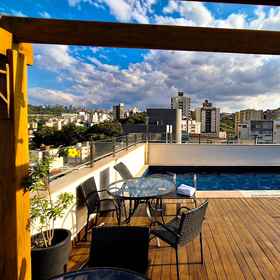More about hotels in Brazil
Brazil, the world's fifth largest country in geographical expanse and the largest nation in Latin America, comprises slightly under half the land mass of the South American continent and shares a border with every South American country except Chile and Ecuador. It is the size of the continental United States excluding Alaska. Brazil's physical environment and climate vary greatly from the tropical North to the temperate South. The landscape is dominated by a central highland region known as the Planalto Central (Brazilian Highlands, or Plateau of Brazil) and by the vast Amazon Basin which occupies over one-third of the country. The central plateau juts into theseaina few areas along Brazil's 4,500-mile-long, (7,240-kilometer-long) coast, but it more often runs parallel to the ocean, creating a fertile, lowland area. Brazil is a land rich in natural resources, principally iron ore, bauxite, manganese, nickel, uranium, gold, gemstones, oil, and timber.
Nearly all Brazilians speak Portuguese, a Romance language, belonging to the Indo-European language family. The Portuguese language was introduced to Brazil by the Portuguese in the early sixteenth century. Before the arrival of the Portuguese, the native population spoke languages belonging to at least four major language families: Arawakan, Gê, Carib, and Tupi-Guarani. Tupi-Guarani—which was spoken by coastal Indians, the first to come into extensive contact with the Portuguese—served as the basis forlingua geral, a language developed by the Jesuits for their missionary work with the Indian population.
Aside from a small number of recently contacted indigenous peoples, all Brazilians speak Portuguese. Brazilian Portuguese differs somewhat in grammar, vocabulary, and pronunciation from the language of Portugal. Brazilian Portuguese contains a large number of indigenous terms, particularly Tupi-Guarani words for native plants, animals, and place-names that are not found in continental Portuguese. While regional accents exist in Brazil, they are not very pronounced, and native Portuguese speakers from one region have no difficulty understanding those from other regions. The vast majority of Brazilians are monolingual in Portuguese, although many middle-class and elite Brazilians study English and to a lesser extent Spanish, French, and German. Brazilians are very proud of their linguistic heritage and resent that many foreigners, particularly North Americans, think Brazilians speak Spanish.
How to Get There?
By Flight
Rio de Janeiro–Antonio Carlos Jobim International Airport (IATA: GIG, ICAO: SBGL), popularly known by its original name Galeão International Airport, is the main airport serving Rio de Janeiro, Brazil. It is the country's second-busiest international airport. It is named after Praia do Galeão (Galleon Beach), located in front of the original passenger terminal (the present passenger terminal of the Brazilian Air Force) and wherein 1663 the galleon Padre Eterno was built and since January 5, 1999, also after the Brazilian musician Antonio Carlos Jobim. Galeão Airport ]explicitly mentioned in his composition Samba do avião. It is the largest airport site regarding the area in Brazil. No direct flight is available from Singapore. Alternatively, you can book a connecting ticket between airlines such as Emirates via Dubai, Singapore Airlines/Lufthansa via Frankfurt, Singapore Airlines/Qantas/LATAM via Sydney/Santiago/Chile, KLM via Amsterdam, Qatar Airways/LATAM via Doha/São Paulo, Singapore Airlines/Iberia via Munich/Madrid. Air France via Paris, SWISS/Iberia via Zürich/Madrid, Qatar Airways/Alitalia via Doha/Rome, Qatar Airways/Goals via Doha/São Paulo. Singapore Airlines/British Airways via London, Singapore Airlines/South African/LATAM via Johannesburg/São Paulo, SWIS via Zürich, Qatar Airways/Royal Air Maroc via Doha/Casablanca and Singapore Airlines/Turkish Airlines/Royal Air Maroc via Istanbul, Casablanca.
What to do There?
Food Hunting
Food is a must try when you are in Brazil. Rice, beans, and manioc form the core of the Brazilian diet and are eaten at least occasionally by all social classes in all parts of the nation. Manioc is a root crop that typically consumed as farinha, and manioc flour sprinkled over rice and beans, or farofa, manioc flour sautéed in a bit of oil with onions, eggs, olives, or other ingredients. To this core, meat, poultry, or fish are added, but the frequency of their consumption closely tied to financial well-being. While the middle and upper classes may consume them on a daily basis, the poor can afford such protein sources far less often.
Traditionally the most important meal of the day is a multicourse affair eaten after midday. For middle-class and elite families it might consist of a pasta dish or meat or fish course accompanied by rice, beans, and manioc and a sweet dessert or fruit followed by tiny cups of strong Brazilian coffee calledcafezinho. For the poor, it would be primarily rice and beans. The evening repast is more straightforward, often consisting of soup and perhaps leftovers from the midday meal.
As Brazil urbanises and industrialises, the leisurely family-centred meal at midday replaced by lanches (from the English, "lunch"), smaller meals usually consumed in restaurants, including ones featuring buffets that sell food by the kilo and such ubiquitous fast-food eateries as McDonald's. The poor, who cannot afford restaurants, are likely to eat the noon meal at home, to buy snacks sold on the street, or to carry food with them to work in stacked lunch buckets. In rural areas, itinerant farm labourers who are paid by the day and who carry such buckets have been dubbed bóias-fries, "cold lunches."
Porto de Galinhas
Have you been itching for lush rainforests, fantastic cities, tropical islands, and heavenly beaches? Then you’ve been itching for a Brazilian adventure. You’ll find colonial towns that will make you feel that you’ve stepped back in time, red-rock canyons that will make you feel that you’ve stepped onto another planet, and awe-inspiring waterfalls and jungles that will make you wish you could stay forever. One of Brazil’s booming beach destinations, Porto de Galinhas attracts hordes of tourists during holiday times. So what makes Porto de Galinhas so unique? For starters, it boasts pretty white sand beaches, beautiful weather, warm waters, and a nice selection of accommodations in all price ranges. But what truly sets Porto de Galinhas apart is the stunning natural pools that form in the reefs at low tide where visitors can swim with large schools of colourful fish.
Campos do Jordao
Also known as the Switzerland of Brazil, this town is the highest in the country, located more than 1,600 meters (5,300 feet) above sea level in the beautiful Mantiqueira Mountains. Because it sits at such a high elevation, this resort town offers visitors a refreshing escape from Brazil’s heat during the summer months. Campos do Jordao is probably best known for its Winter Festival, a famous classical music event held in July that draws musicians from around the world. This town is also a popular draw with active visitors, who can choose from a large variety of outdoorsy outings, including horseback riding, jeep tours and cable car rides.
Lencois Maranhenses National Parks
For most people, Brazil conjures up images of stunning beaches and verdant jungles — not dunes. But one of its most fascinating national parks, Lencois Maranhenses, is home to massive dunes. But this is not the desert. During July, torrential rains create gorgeous clear lagoons that can reach depths of 3 meters (10 feet) in some areas. Interestingly enough, even though these pools are temporary — disappearing during the dry season — there are fish in them. Swimming is allowed, but visitors should be prepared for warm waters. Temperatures in these pools can be as high as 30 °C (87 °F).
Florianopolis
Also known as Floripa, the 42 beaches of Florianopolis are popular with surfers, partyers and sun worshippers. Arguably, its most famous beach is Joaquina, which boasts enormous dunes and excellent waves. Though as of late, its neighbour Praia Mole has been stealing some of Joaquina’s thunder. Travellers who like to hang out with the rich and famous should head to Jurere, which boasts large homes and some of the best nightclubs in the area. For those seeking a little solitude, Lagoinha does Leste the beach they’ll want to visit. One caveat, this beach requires about a two-hour hike to reach it.
Where to Stay?
The Plaza Sao Rafael Hotel
The Plaza Sao Rafael Hotel situated in the city of Porto Alegre, and it belongs to the Network Plaza Hotel. The hotel is one of the most famous of Rio Grande do Sul the diversity of rooms for events, especially the Jewish community, as well as exhibitions, conferences and weddings. It also has restaurants and shops. In addition to hosting rooms in the middle, there is the Events Center Plaza São Rafael, located across the street, Avenida Alberto Bins.
The Hotel Portobay Rio De Janeiro
The Hotel Portobay Rio De Janeiro located in the heart of seductive Copacabana beach; on Avenida Atlântida, the PortoBay Rio de Janeiro hotel offers personalised service, a stunning view of the beach, Corcovado and the Sugar Loaf. It is a perfect combination of leisure, business, tourism and culture. The 117 apartments with private balconies or panoramic windows allow you to experience the life of this beautiful city.
Intercontinental Sao Paulo
This renovated luxury hotel offers contemporary elegance at its best. Located right in the heart of the city and a block away from the financial and commercial area, Paulista Avenue, this hotel will entice you to experience the best side of the city during your holidays with free HSIA. Nearby attractions include the Shopping Cidade São Paulo and the Trianon Park among other venues for entertainment and lovely restaurants to taste unique dishes from around the world.






































 Facebook
Facebook Instagram
Instagram TikTok
TikTok Youtube
Youtube Telegram
Telegram